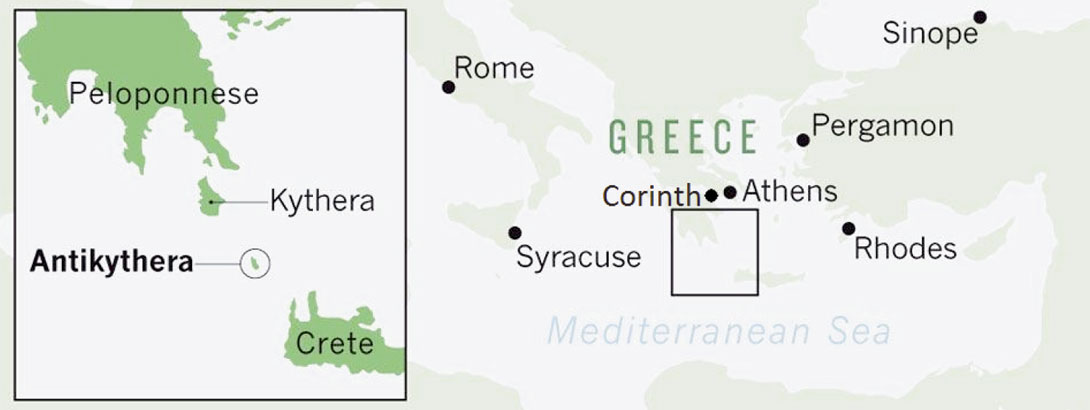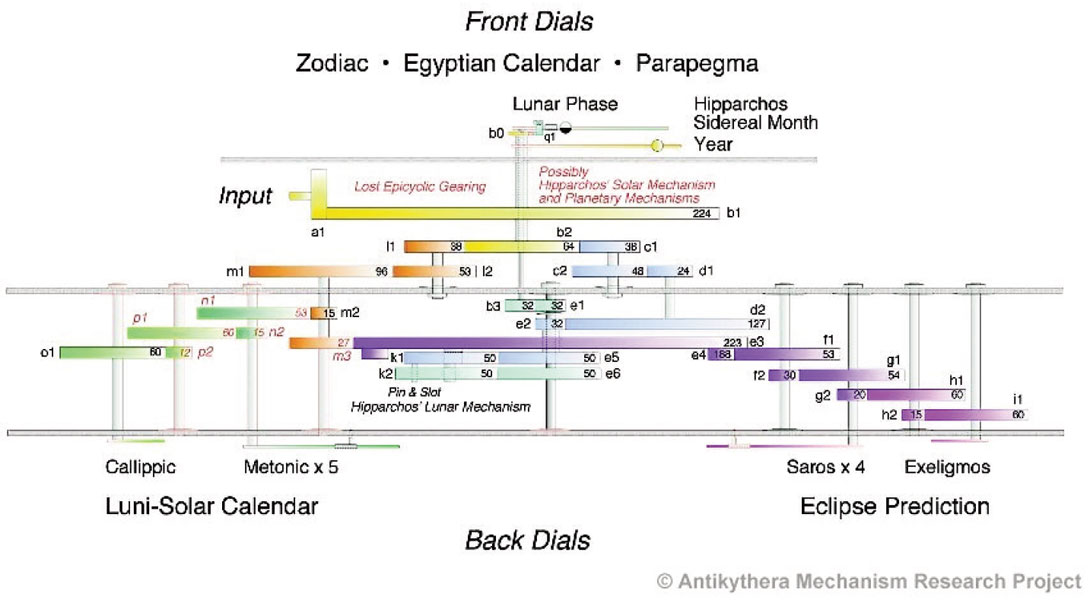This month’s topic is one that I have been eager to present – it contains almost everything that makes archaeology a fascinating discipline.
Occasionally an archaeological discovery is made that completely changes accepted wisdom. The Antikythera mechanism, as it is known, has done this. Doubly fascinating is that although an object of intense study and interest for over a century, it has only revealed the full scope of its secrets with the recent application of modern scientific methods, especially Xray tomography (Antikythera mechanism, 2012). A large coordinated effort called The Antikythera Mechanism Research Project is spearheading ongoing research and analysis (antikythera-mechanism, 2012).
The bronze device was found in a seafloor wreck by Greek sponge divers in 1900, near the small island of Antikythera (literally, opposite Kythera; see map). It has been dated to the 1st century BC. After ~2,000 years underwater, it is highly oxidized and covered in calcareous concretions, so until recently it has been difficult to ascertain exactly what it is and how it works. However, from the moment it was pulled out of the Mediterranean ooze, there was no doubt it was a highly complex mechanical device, with a multitude of cogs and gear mechanisms clearly apparent. In fact, at first it was thought that it was a modern device that had only recently fallen by chance into the ancient wreck.
It has now been conclusively shown that the mechanism determined the positions of the celestial bodies in our solar system, with a hand crank adjusting the date. Dials on the front and back plates showed the positions of the Sun and Moon as seen from the Earth, as well as Moon phases and eclipses. It also determined the dates of the ancient Olympic Games on their 4- year cycle. There is strong evidence that the device predicted the position of the five then-known planets; this is based on gears that existed but only fragments of which were found, and literary references hitherto dismissed as exaggerations.
In order to accurately model the various elliptical orbits, epicyclic and pin & slot gearing (Carman, Thorndike, & Evans, 2012) mechanisms were used. These advanced systems were unknown in Europe until at least 1,000 years later! It is almost inconceivable that such a device was created only once and in isolation. It implies that there must have existed, at least in pockets, much more advanced and integrated knowledge in mathematics, mechanics, metallurgy, astronomy, and related fields, at much earlier dates, than previously believed. It has been speculated that the lineage of this complex mechanical technology began with the ancient Greeks, continued through the Byzantine civilisation, on to the Arab world, and finally entered continental Europe via the Moorish influence in Spain during the Middle Ages.
X-ray CT imaging has accurately identified the gearing mechanisms embedded within the oxidized metallic mass. Perhaps even more importantly it is now possible to read most of the inscriptions on the various gears and plates. This has helped with the analysis, as actual words have been deciphered, including the names of months and zodiac symbols. The words are all in Koiné (common) Greek script, confirming the device’s age and Hellenistic origins. One popular theory has identified the island of Rhodes as the place of manufacture, with possible connections to Posidonius and Hipparchus. Another theory identifies a possible link with Corinth and thus Archimedes. Although he would have died some 120 years prior to the creation of the device, it is possible that there remained ties between the scientific communities of Corinth and its Sicilian colony Syracuse, where Archimedes lived. The ship has been identified as Roman; many questions remain.
There are several classical references to orreries that sound similar to the Antikythera device, including one in a 1st century BC work by Cicero. He says that after the siege of Syracuse, during which Archimedes died (in 212 BC), the Roman General Marcus Claudius Marcellus brought two machines made by Archimedes back to Rome as war booty. A contemporary of the General is quoted as saying that the devices, “which displayed the motions of the Sun and Moon, and the five planets, or wandering stars, could not be represented by the primitive solid globe. And that in this, the invention of Archimedes was admirable, because he had calculated how a single revolution should maintain unequal and diversified progressions in dissimilar motions.” (Antikythera mechanism, 2012).
The story of the Antikythera mechanism is still unfolding, and is sure to reveal further secrets that connect current science and technology with their origins in the Mediterranean world of two thousand years ago.
Next month’s article: Natural gas liquids
Oliver Kuhn (Apoterra Seismic Processing Ltd.) is a long-time member of the CSEG, and a past president (2006). He strongly believes that staying in touch with other branches of science nurtures our sense of discovery, and makes us better geophysicists.














Share This Column